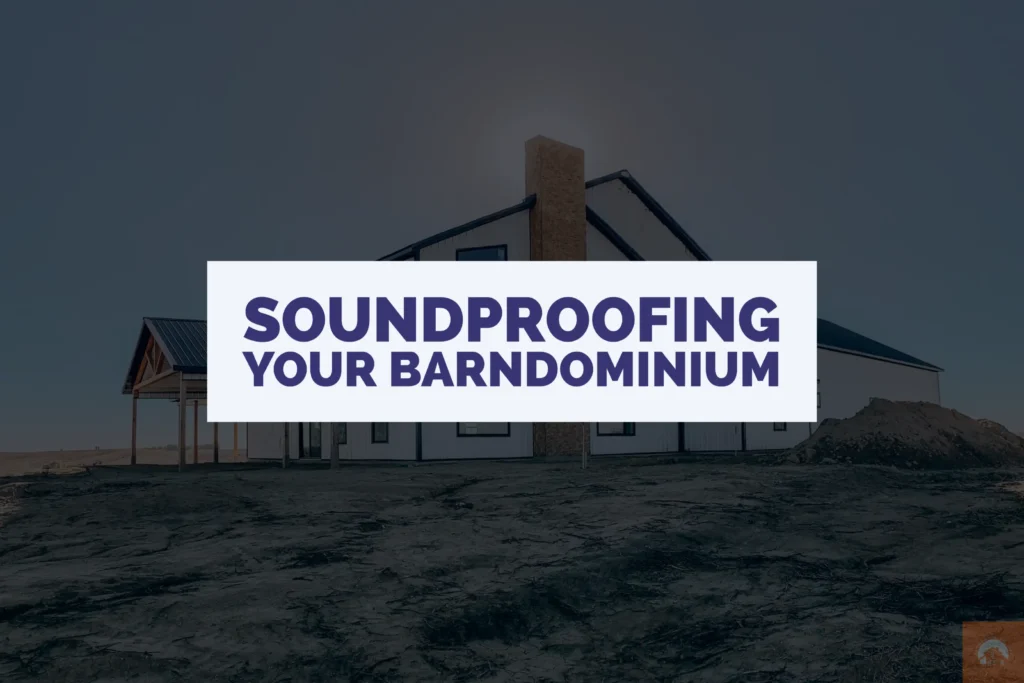Phone:
(770) 925-2188
Physical address:
4230 Lawrenceville Hwy
Lilburn, Georgia.
Ever wondered how to turn your noisy metal barndominium into a silent one?
You’re not alone. So many others are also searching the same!
This guide dives deep into the whys and hows of muffling noise in your metal barn home, offering you a roadmap to peace and quiet.
From understanding the unique challenges these structures present to implementing practical sound-dampening strategies, we’ll cover it all.
So, let’s get started, shall we?

Why do barndominiums seem to intensify every sound?
Unlike traditional homes with their brick, wood, and drywall, metal barndominiums are essentially steel echoes chambers which means that the sound waves bounce off hard surfaces more readily, leading to increased noise levels.
In the U.S., where barndominiums are gaining popularity for their durability and affordability, the importance of soundproofing cannot be overstated.
It’s not just about comfort; it’s about creating a livable space for everyone living in and around.
But why go through the hassle of soundproofing?
Beyond the obvious benefit of reducing noise pollution, there’s more to it.
Soundproofing can improve your quality of life, enhance privacy, and even comply with regulations.
Yes, places like the workplace are governed by OSHA noise levels to protect hearing. While your home might not need to meet these strict standards, it’s a clear indicator of the importance of managing noise levels for health and comfort.
Diving into the world of soundproofing can feel like exploring a dense forest. Each path offers a unique solution to combat noise pollution in your metal barndominium.

Here’s a closer look at the arsenal of materials at your disposal, each with its superhero-like abilities to fend off unwanted sound:
By mixing and matching these materials, you can orchestrate a symphony of silence in your home, tailored precisely to the frequencies and volumes you wish to manage.
When it comes to soundproofing, the saying “you get what you pay for” rings especially true.
The choice of material not only affects the degree of calmness you can achieve but also the depth of your pockets.
For instance, opting for Cellulose or Denim insulation might set you back $1,500 to $2,000 for a standard-sized room in a rural area of the USA. However, if you’re leaning towards high-end solutions like Vinyl Sound Barriers or Custom Fabric-Wrapped Acoustical Panels, the budget could stretch to $3,000 – $4,000, reflecting both the material costs and the labor involved in precision installation.
Consider the case of one of my client in Texas, who chose a combination of Vinyl Sound Barriers and Wood Wool Acoustical Panels for their barn-inspired living space.
The total project cost came to around $5,500, a testament to the homeowner’s prioritization of acoustic comfort over expense.
This example underscores the variability in soundproofing costs, influenced by material choice, labor rates, and the size of the area being treated.
Need a Sound-proof Barndominium Floor Plan?
We filtered out the trending barndominiun design layouts in one place.
Navigating the waters of regulatory compliance can add another layer of complexity to your soundproofing project. In the USA, local building codes and noise ordinances often dictate the acceptable noise levels, which can vary widely from one zone to another.
For instance, residential areas may have a cap of 55 dB during the day, mirroring the serene environment expected in such communities.
Understanding these regulations is crucial, as non-compliance can result in fines or mandatory modifications post-construction.
Engaging with a local expert or consulting with the building department before embarking on your project can save you from future headaches.
Compliance not only ensures your project meets legal standards but also aligns with community expectations for noise levels, contributing to a harmonious living environment for all.
Insulation primarily aims to control temperature and energy efficiency within a building.
Some insulation materials, however, also possess sound-dampening properties. For example, fiberglass and cellulose insulation can reduce noise transmission to some extent, thanks to their dense, fibrous structures which can absorb sound waves.
If a barndominium in the USA has already been insulated with such materials, the homeowner has inadvertently invested in a basic level of soundproofing.
The cost covered by this initial insulation for soundproofing purposes can be substantial. Fiberglass insulation, for instance, might reduce noise by about 10-20 decibels, depending on its density and where it’s installed.
However, achieving a higher level of sound reduction—especially for specific types of noise like footsteps, music, or conversation—often requires targeted soundproofing solutions beyond general insulation. Materials like mass-loaded vinyl (MLV), acoustic panels, and specialized soundproofing underlayments are designed specifically for noise control and can be more effective at soundproofing than general insulation materials.
For someone who has already insulated their barndominium, the need to “pay again” for soundproofing boils down to their specific noise reduction needs. If the existing insulation does not meet their soundproofing requirements, additional investments will be necessary.
Consider the case of John (my client), a homeowner in rural Ohio who insulated his 2,000 sq ft barndominium with high-density fiberglass insulation at a cost of approximately $3,000.
While this insulation provided a comfortable thermal barrier, John noticed that sound from his workshop easily traveled to the living areas.
To address this, he decided to install MLV in the workshop area and acoustic panels in the ceiling of the living spaces, costing an additional $2,500.
In this scenario, John’s initial investment in insulation contributed somewhat to his overall soundproofing. However, to achieve the desired level of quiet, he needed to invest in additional, more targeted soundproofing solutions.
When targeting specific areas for noise reduction, precision and strategy are key.
In conclusion, reducing the noise of your metal house is a necessity that pays back in terms of a healthy environment, a peaceful mind, adherence to compliance and increased future resale value. Investing in utilization would surely reduce the need to incur additional cost in keeping your home quiet.